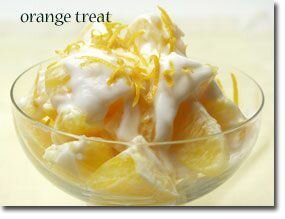If you don't know what to serve for dessert tonight ...
Try this tangy dessert tonight. One serving contains just 81 calories!

Ingredients:
- 1/2 tsp grated lemon rind*
- 1/2 TBS fresh lemon juice
- 2 TBS honey
- 2-1/2 TBS low-fat yogurt
- 2 medium oranges
- Optional: Top with orange zest
- In a small bowl, whisk lemon rind, lemon juice and honey until the honey is incorporated.
- Add yogurt and whisk thoroughly.
- Peel and separate the individual sections of the orange. Be sure to remove the membrane covering from each section. Cut the sections into thirds crosswise. Place in 2 dessert bowls.
- Spoon sauce over the oranges.
Serves 2
Printer Friendly Version of 10-Minute Orange Treat
In-Depth Nutritional Profile for 10-Minute Orange Treat
Healthy Food Tip
Do you know where in the digestive system vitamins and minerals enter the bloodstream?
While different vitamins and minerals are absorbed as they pass through different areas of the digestive tract (mouth, esophagus, stomach, small and large intestine), they technically never enter the bloodstream directly from the digestive system. This is because these nutrients are first absorbed from the digestive tract into the epithelial cells that line the digestive tract before they enter the bloodstream. Once they have been absorbed into the epithelial cells they are no longer considered to part of the digestive system. (In the case of highly fat-soluble nutrients, like fat-soluble vitamins, there is yet another step between absorption and the bloodstream. After these water-soluble nutrients get packaged by the endothelial cells lining the intestine in more complicated molecules, they are sent not into the bloodstream, but into the vessels of the lymphatic system. Only following their passage through the lymphatics do they eventually arrive at the bloodstream.)
As noted above, nutrients undergo absorption in different areas of the digestive tract. For example, some nutrients can even undergo absorption at the very beginning of the digestive tract-inside the mouth! We know that vitamins B6, B12, C, and folate can be absorbed in this way, and so can the mineral zinc. (You'll find "sublingual" or "under-the-tongue" supplements in most health food stores for exactly this reason.) Exactly how much vitamin and mineral absorption takes place in your mouth, however, depends on the form in which these vitamins and minerals are found in your food, how long you chew the food in question, the enzyme contents of your saliva, and many other critical factors. In general, we get relatively little vitamin and mineral absorption in the mouth, but what we do get may be very important. There is good research in this area for supplements, and we need better research in this area for foods.
After the mouth, the next potential absorption site in our digestive tract is the stomach. While some vitamin and mineral absorption may also take place directly through the wall of your stomach, this amount appears to be minor and has not traditionally been considered to be part of our vitamin and mineral absorption process. Exceptions here would be the minerals, copper, iodine, fluoride, and molybdenum, which may be significantly absorbed directly from the stomach.
The small intestine is by far the most important site in our digestive tract for both vitamin and mineral absorption. The small intestine is quite long (many feet in length) and virtually all vitamins and minerals can be absorbed from different areas along its surface. The part of the intestine closest to the stomach (called the duodenum) and the middle part of the small intestine (called the jejunum) specialize in absorption of most minerals. The vitamins are also spotlighted in these areas, with the exception of vitamin B12, whose primary absorption site is the very last segment of the small intestine, called the ileum. Literally hundreds of nutritive substances are absorbed from the small intestine.
The last part of the digestive tract-the large intestine-is particularly important for the absorption of vitamin K, biotin, and the electrolyte minerals (sodium, chloride, and potassium).
For more information on this topic:
If you have any questions about today's Healthy Food Tip Ask George Your Question

No comments:
Post a Comment